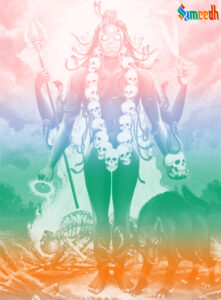In Hinduism, Lord Shiv is worshipped in various forms, each representing different aspects of his divine nature and attributes. One of the fierce and powerful forms of Lord Shiv is known as Mahakala or Mahakal.

The term “Mahakal” can be translated as “Great Time” or “Great Black One.” This form of Shiv is often depicted as a fierce and wrathful deity, symbolizing the destructive and transformative forces of time.
Here are some key aspects associated with the Mahakal form of Lord Shiv:
- Destruction and Transformation: Mahakal represents the destructive aspect of Lord Shiv, signifying the inevitable process of destruction and transformation in the cycle of creation, preservation, and dissolution in the universe.
- Time and Eternity: The name “Mahakal” highlights the concept of time as a powerful force that governs the universe. It is a reminder of the transient nature of all things and the eternal reality beyond the changing cycles of time.
- Fierce Appearance: Mahakal is often depicted with a fierce and terrifying appearance, adorned with serpents, skulls, and other symbolic elements. This fierce form is a visual representation of the intense and uncontrollable nature of time and destruction.
- Symbolism of Skulls and Rosary: The imagery associated with Mahakal may include a garland of skulls, symbolizing the transcendence of life and death. He may also be depicted holding a rosary (mala) representing the cyclic nature of time.
- Worship and Devotion: While Mahakal is a fierce and destructive form, devotees also worship him for protection and liberation from the cycles of birth and death. Devotion to Mahakal is seen as a way to overcome the fear of death and embrace the eternal aspect of the divine.
It’s important to note that the worship of Mahakal is often part of esoteric and tantric traditions within Hinduism. Devotees seek the blessings of Mahakal for inner transformation, spiritual awakening, and liberation from the cycle of reincarnation. Mahakal is also revered in Tibetan Buddhism, where he is known as a Dharmapala (protector of the dharm) and is often depicted in thangka paintings and sculptures.